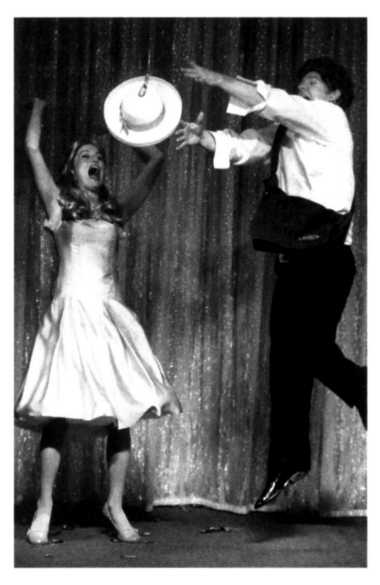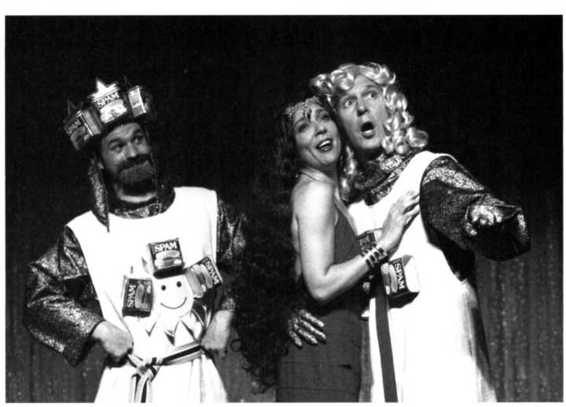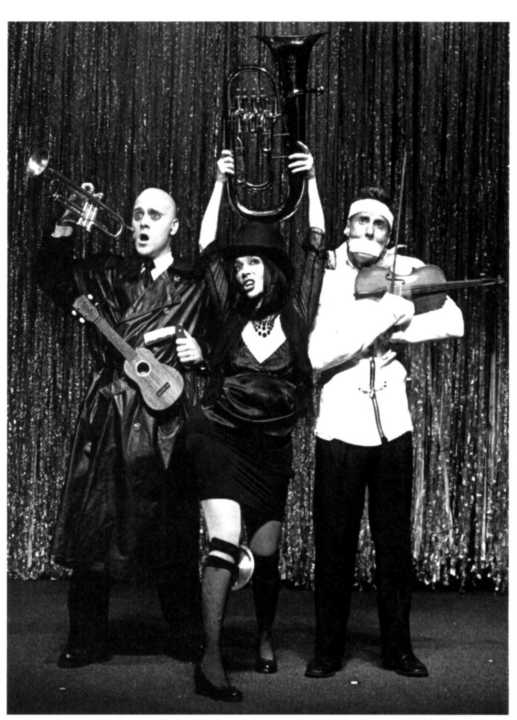Forbidden Broadway: Behind the Mylar Curtain (104 page)
Read Forbidden Broadway: Behind the Mylar Curtain Online
Authors: Gerard Alessandrini,Michael Portantiere

At first, losing the Douglas Fairbanks seemed a misfortune for our show. But it
turned out to be a happy accident, because we moved to the best home we ever
had: the 47th Street Theatre, located at 304 West 47th St. between Eighth and Ninth
avenues.
After a short break, we remounted Forbidden Broadway: Special Victims Unit, but
we revamped it for the new space. Phill George and I added a slew of new numbers
lampooning the recent Broadway hits: Spamalot, Spelling
Bee, Doubt, etc. I wasn't sure how our show would play in
the new venue, but the laughter was more rapturous than
it had been for years. The theatre has great sight lines and
better acoustics than any other space we've ever played
in NewYork; the new material hit the bull's-eye there, and
the older numbers seemed funnier than ever.

laughs in the Piazza: Sarah Krulwich of
the New York Times captured this action
shot of Megan Lewis and Jason Mills.
Because we added so much new material, we reopened
SVU for the press, and we got some of the best reviews
in our history. This was largely due to the talents of Ron
Bohmer, Megan Lewis, Jason Mills, and Jeanne Montano,
plus the inclusion of our outlandish parody of The Light
in the Piazza. Also, it didn't hurt us that many of the rave
reviews of Spamalot compared that show to ours.
A lot of spoofable things were happening on Broadway
at that time. For one thing, Robert Goulet was appearing
in La Cage aux Folles. Ron Bohmer kept suggesting that
we should "do" him, and when we did, the audience went
nuts.
I had some trouble figuring out how to handle The
Light in the Piazza. Originally, I wrote a parody of the song "Dividing Day," called "Dividing Play," all about the fact that the critics loved the show
but it may have been a bit too cerebral for the masses. Jeanne Montano performed
the number brilliantly, and we were sure it was going to go over really well, but it
didn't. John Freedson said, "It's thoughtful and insightful, but it's not really funny."
Phill George said, "Just cut the song and spoof the flying hat." I said, "That's a terrible
idea." But we tried it, and it was hilarious.

Jason Mills, Jeanne Montano, and Ron Bohmer steal our jokes back from Spamalot.
The genesis of our Doubt/Virginia Woolf parody was quite out of the ordinary. In
2005, John Patrick Shanley's play Doubt, starring Cherry Jones, was playing right across
the street from a stunning revival of Edward Albee's Who's Afraid of Virginia Woolf?
starring Kathleen Turner. During awards season, Jones and Turner were in competition for all the major honors for best actress in a play. (Cherry won the Tony.) Theatre
critic Howard Kissel told me that, at a reception after one of the awards shows, Jones
had offhandedly said she thought it would be funny if Forbidden Broadway put the
two plays together. She imagined her character in Doubt, a severe nun, going across
the street to give an intervention to Kathleen Turner as the alcoholic Martha in Virginia Woolf.
I explained the concept to Phil] George, and this time he was the one who said,
"That's a terrible idea." But I kept thinking about it and chuckling to myself, so I kept
bringing it up to Phill. Eventually, I wore him down, and he said, "All right! Go ahead
and write it, and I'll stage it." When he looked at my script, he grunted, "The lyrics are okay, but your dialogue is trite, and there
aren't enough real lines from Doubt and Virginia Woolf." So he did an excellent rewrite,
alternating actual lines from the two plays
and throwing in a few barbs that he and I
wrote. What we ended up with was a wonderful little one-act play written by Cherry
Jones, Phill George, Gerard Alessandrini,
John Patrick Shanley, and Edward Albee.
Not a bad team! That sketch kept audiences
doubled over in laughter for more than a
year.

"Squeaky Todd": Jared Bradshaw as Michael Cerveris, Jeanne
Montano as Patti LuPone, Michael West as Manoel Felciano.
As it turned out, SVU was one of my favorite editions of the show, as well as the
most successful. It was very tourist-friendly;
when people saw "SVU" in the title, they immediately made the connection to Law &
Order. That edition also had mass appeal
because Alvin Colt was at the peak of his
inventiveness with the costume designsand this from a ninety-year-old man.
One of the most memorable moments
in the history of Forbidden Broadway was
the first day we rehearsed the Chitty Chitty
Bang Bang number with Alvin's "car" costume. He turned Megan Lewis into a showgirl/automobile, with her shapely hips as
tires, her head as a radiator, and her breasts as headlights. When she beeped her
horn, her high-beams would light up. Sheer comic genius.
A number that was very difficult (all Sondheim rewrites are!) but enormous fun to
put together was our take on John Doyle's revival of Sweeney Todd, in which the actors doubled as the orchestra. There was a lot of buzz about Patti LuPone playing the
tuba as well as the role of Mrs. Lovett in the show. Was this ripe for parody or what?! Of
course, we gave Patti a tuba. (Well, not exactly; we could only afford a French horn.)
We also had her play the "cymbals," which were actually the lids of two cooking pots
strapped inside her knees. I rechristened the show "Squeaky Todd," and the actors
did their best to play off-key.
It was a blast keeping the show updated that summer. And the new location, the
fabulous costumes, and the plethora of new shows on Broadway really got us excited
about creating the next edition.
"Sour Charity"
CHORUS
[CHRISTINA APPLEGATE enters; music changes.]
CHRISTINA
[Music changes.]
